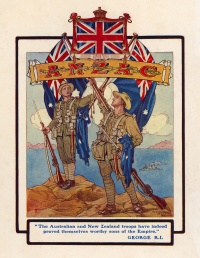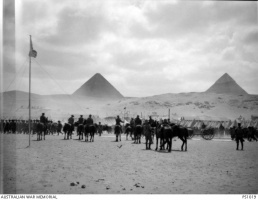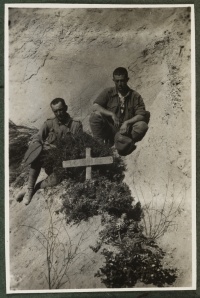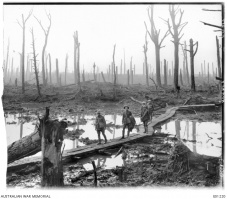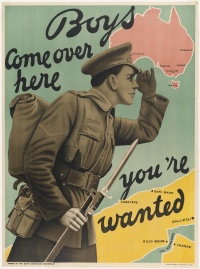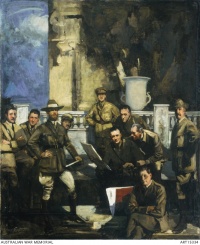Introduction↑
As a democratic nation which relied exclusively upon citizen volunteer soldiers to serve in the Great War, Australian troops’ attitudes toward the war, their membership of a military force and their treatment by their government, assumed at the time an unusual significance. For a decade before 1914, British government ministers had been attempting to persuade Australian governments (or rather those members who visited London to participate in various imperial conferences) to agree to contributing forces to serve the empire in the event of a major war. The precedents of Australian colonial forces serving the British in the Sudan in 1885, in China (1900-1901) and especially in South Africa from 1899 demonstrated the feasibility of using Australian troops in this way. However, the (Australian) Defence Act of 1903 precluded the recruitment of permanent infantry and prohibited the employment of the Militia outside Commonwealth territory. Accordingly, Australian ministers and military officers prepared plans for the formation of an expeditionary force in the event of war (a development that has proved contentious in the historiography but which appears to be well founded).
This explains why the Australians who served overseas in the Australian Imperial Force did so as civilian volunteers, as neither regular soldiers nor conscripts. (Attempts to introduce conscription for overseas service were twice defeated in referenda: in 1916 and 1917.) Australian soldiers expressed a distinct national identity through their appearance (they wore the AIF’s pea green/khaki uniform, complete with slouch hat, turned up over the left ear, with its “rising sun” badge) and even more by their attitudes and behaviour.
Methodology↑
Obtaining a justifiable understanding of the attitudes held or expressed by Australian volunteer soldiers during the Great War is difficult, notwithstanding the immense lode of contemporary evidence preserved in Australian libraries, archives and within families, some of which has been published. Despite the survival of diaries, letters and memoirs written by thousands of individuals, aspects of their use as historical evidence remains complicated by two major factors. First, because no systematic or consistent contemporary survey was ever conducted, no one can say with any certainty why men volunteered for the AIF. Second, and even more importantly, because the “Anzac legend” has become such a central part of the Australian understanding of its role in war, and of the mythology of its service in the Great War in particular, it is very difficult to discern the extent of actual attitudes held by the AIF’s members as opposed to the tenets of the legend. For example, the incidence of “larrikinism” – the high-spirited, independent indiscipline celebrated in the legend – is problematic. While it is clear that the AIF adopted a more casual or pragmatic attitude to military discipline than comparable British imperial armies, what that meant for the character of the entire force remains unclear. In the absence of statistically based studies of the incidence of, say, indiscipline, inevitably scholars employ qualitative or anecdotal evidence. The validity or reliability of this can only be determined by comparing any individual evidence against a body of similar evidence. The probability is that the main features of the AIF enshrined in the “Anzac legend”, such as mateship and a casual attitude to military ranks and discipline, are sustained by the evidence, though claims of Australian exceptionalism need to be treated cautiously.
Historiography↑
The literature on Australian volunteer soldiers’ attitudes to the conflict in which they fought is both extensive, and in another sense limited. Because of the scale of enlistments (some 417,000 men out of a total population of about five million people volunteered, and about 315,000 served overseas) and the significance of the war in the Australian understanding of the idea of nationhood, “the war” looms large in Australian historiography. During the war the overwhelmingly literate AIF produced dozens of “unit serials” – magazines that reflected their members’ attitudes – and almost every battalion published a history after the war.[1] Many men wrote and often published memoirs, while the strong “ex-service” movement documented former soldiers’ memories and attitudes in the decades after 1918. After several decades of respectful neglect, from about the 1980s, a boom began in the publication of secondary works, many based on research using the abundant sources. This literature encompasses both academic studies and popular histories of varying quality, but also a large body of memoirs, published sources (such as letters) and biographies. There is, therefore, relative to the size of the force, an almost intimidating lode of primary and secondary evidence. One caution which this mass of evidence imposes is an awareness of the dangers of generalising. For example, the AIF is often represented as having been indifferent or hostile to organised religion, perhaps reflecting the apathy or antagonism of a large but unquantifiable minority of men in Australia before 1914. Whether this attitude changed or was confirmed during or as a result of the war, by exposure to military chaplains (all civilian clergymen, who also volunteered) remains to be established; if it ever can be.
There are a number of notable works. The first extensive expression of the Anzac legend can be found in The Anzac Book, edited on Gallipoli by Charles Bean (1879-1968) using verse and art created by Australian and New Zealand soldiers on Gallipoli late in 1915. Bean’s official history, written over twenty-odd years after the war, articulated and elaborated Bean’s vision. But it is important not to accept that Bean was merely a propagandist or a romantic. While Bean was ultimately responsible for fostering some of the most persistent myths of the AIF (for example, that its members mainly or characteristically came from the “bush” – rural communities – whereas they actually came from towns and cities) he was also the most careful observer and recorder of the AIF’s members. He was often shy in speaking directly to its members (or rather its non-commissioned members) but he recorded vast quantities of observations over the entire war, filling over 200 notebooks.
The modern revival of interest in the AIF and Australia’s Great War can largely be traced to Bill Gammage’s book, The Broken Years: Australian Soldiers in the Great War, first published in 1974 and rarely out of print since.[2] Based on his Australian National University PhD, Gammage’s work used, virtually for the first time, the hundreds of soldiers’ diaries, letters and memoirs collected but not used by the Australian War Memorial, and contact with dozens of aging veterans. Gammage’s achievement was to use the soldiers’ own words to explore their experience of war, along the way reflecting on their attitudes to war, allies, death, their enemies, fighting, discipline, officers, civilians and to the prospect of death and wounds. As a pioneering work it has rightly inspired and informed other scholars and further studies have confirmed, refined or challenged its arguments. It remains a starting point and a work of enduring value.
For many years Emeritus Professor Peter Dennis created and has maintained the “AIF Data Base”, a compilation of biographical details on every member of the AIF, collated from official and private sources and now administered by the University of NSW Canberra. Professor Dennis’s research provided much of the evidentiary basis of the volume that he and Jean Bou wrote for the Oxford Centenary History of Australia and the Great War, The Australian Imperial Force, published in 2016. This book provides an authoritative analysis of the AIF’s composition based on a 100 percent sample of its members’ original documentation.
While assertions and assumptions about the AIF’s character appear in virtually all of the vast range of academic, popular and amateur books published on Australia’s part in the Great War, relatively few works have actively investigated its social composition and character. Two books that warrant notice are Peter Stanley’s Bad Characters: Sex, Crime, Mutiny, Murder and the Australian Imperial Force (2010) and Nathan Wise’s Anzac Labour (2014).
Both are based on the scrutiny of the massive lode of evidence available on the AIF, including official sources and contemporary sources such as unit journals and magazines, but crucially including the rich resource of letters, diaries and memoirs preserved in Australian archives and memoirs. Stanley’s Bad Characters argues that the AIF’s volunteers remained essentially civilians in their response to the impositions of military life and especially military law. They accepted military discipline when they considered it necessary but negotiated compromises and exceptions in ways characteristic of the AIF and in distinction to other British and dominion forces. Wise’s Anzac Labour demonstrates how AIF volunteers – about 40 percent of them members of trades unions – carried into their military service the expectations and practices of the workplace. They regarded military service as a job with remuneration and limits, and adopted methods of negotiation and protest, including strikes. The clash of civilian volunteers’ and military officers’ expectations and requirements forms the basis of much of the books’ discussion of the AIF’s nature.
The substantive experience of the AIF’s members, and especially their attitudes toward military service and to the war, remains open to further research. It is, however, a question overshadowed by important epistemological and methodological issues. The Anzac legend remains such a powerful factor in the interpretation of the Australian experience of war that it may be difficult to distinguish between what it was and what contemporaries and Australians today would have preferred it to have been. For example, homosexual sex is accepted now but was illegal a century ago. Its presence among AIF volunteers is accordingly hard to discern. Likewise, AIF troops shared a belief in “white” superiority, an unexceptional attitude then but one unacceptable now.
Initial Response to War↑
The 20,000 men who volunteered for the AIF in 1914 and who sailed with the first contingents to Egypt seem to resemble their counterparts in Britain and other dominions. Many were enthusiastic and idealistic; others volunteered in hopes of adventure, or simply to find a job (1914 was a year of severe drought, and many men had been thrown out of work). But no one knows exactly why any of them volunteered for the AIF. What is clear is that “all the boys” did not enlist, as popular memory would have it. Despite the seeming enthusiasm of young men for enlistment, at least in the war’s first eighteen months or so, military service continued to be deeply unattractive to a large minority of the population. In fact, only about two fifths of eligible men donned uniform. The majority of Australian men of military age did not attempt to enlist, and did not serve. Over the period 1911 to 1919 some 473,000 boys appear to have defaulted on their obligation to report for the prevailing “Boy Conscription” scheme. This is more than the total number of volunteers for the AIF.
About 50,000 men volunteered in 1914, but in 1915 165,000, the peak year of enlistments, with 36,575 (the largest single monthly total) joining in July 1915: two thirds of all volunteers had joined by the beginning of the Australian commitment to the Somme. In 1916, 124,355 enlisted; in 1917, 42,854; and in 1918, just 28,883. Enlistment was for the duration of the war and six months after, at among the most generous rates of pay in the world (a reflection of Australia’s pre-war standard of living).
Confronting War↑
In late 1914, the first AIF units were transported overseas; they thought to go to Britain and the Western Front; in fact they remained in Egypt for training and to preserve them from the harsh British winter. In April 1915, Australian troops saw their first substantial action when the 1st Division and the 4th Brigade were committed to the invasion of Gallipoli.
Gallipoli↑
Very few Australian troops – a few hundred veterans of the South African war – had experience of war. Exposure to combat on Gallipoli, and especially close combat at the landing, the defence of the Anzac line and in the August offensive, shocked many – especially the horrific conditions in which they lived in insanitary trenches surrounded by rotting corpses, with all that followed. Charles Bean famously observed in the summer that many men fatalistically accepted that the war had become their life, and that many accepted that release could only come through wounds or death.[3] The eight-month experience of Gallipoli disillusioned many idealistic volunteers. Their principal identifications became the AIF, their units and even more the comrades – “mates” – with whom they served.
Middle East↑
Following the evacuation of Gallipoli, the AIF was re-organised in Egypt, with two new infantry divisions going to France while the Light Horse brigades served in the Middle East. They participated in the defence of Egypt in the Sinai in 1916 and then in the arduous offensives eastward into Palestine in 1917-1918. The men of the Light Horse, who actually were mostly country men (known in Australia as “bushmen”), developed a distinctive culture. Sure of their standing as “white” men, they espoused a disdain for the region’s inhabitants and a sense of superiority over other troops, combining an independent approach to military discipline with a growing proficiency that made them a valuable component of the British Empire’s multi-national army in the war against Ottoman Turkey.
Western Front↑
In early 1916, the AIF’s four and later five infantry divisions went to France, to serve as part of “Anzac” corps until, in late 1917, they formed an Australian Corps of five divisions. At first shocked by the intensity of war on the Western Front (despite the experience of Gallipoli veterans) the AIF was plunged into costly fighting in, and as part of, the battle of the Somme. The Western Front became the AIF’s main commitment in the war, and exposure to massive casualties in a series of major offensives 1916-18 largely shaped its members’ attitudes to the war.
New Attitudes to War↑
Even before the end of the Gallipoli campaign, John McQuilton writes, “[patriotic] rhetoric had begun to wear thin”. Community leaders wondered how they were to “say the same thing in a dozen different ways … telling them over and over again what they already know quite well”. Later volunteers were known by sarcastic nick names (“Dinkums” – that is, “genuine” men, who volunteered despite age or family responsibilities – “Deep thinkers” or “cold-footers”) that suggest the early volunteers’ disdain for those who followed.
Horrors of War↑
Like fighting men the world over, Australians exposed to the brutality of war at first-hand were traumatised; the more so because they came from a society that, while familiar with Saturday night brawls, had had little exposure to violence. Many of the AIF’s wounded were returned to the front after convalescence (5,500 men were wounded three times) and many served until killed or incapacitated. While “shell shock” has been investigated, the effects of this continuing trauma during the war have yet to be explored. It is arguable that exposure to the trauma of combat made some men turn more easily to brutality post-war – statistics of marital assault and crimes of sexual violence imply that the war brutalised former soldiers – though crime statistics refer to all men, regardless of whether they served.
Resistance↑
The AIF was, paradoxically, both a cohesive and remarkably effective force, but also one whose members could not be relied upon to accept military discipline or to even remain in action. While instances of “combat refusal” were rare (a few instances in 1916 and 1918, notably when 120 men of the 1st Battalion refused to return to the line when ordered in September 1918), the AIF had the highest rate of absence of any of the component forces of the British Expeditionary Force. Australians’ rates of absence increased as the war continued, reaching 75 percent of the BEF’s total in mid-1918.[4] Senior officers (British and Australian) deprecated the Australian government’s refusal to sanction the death penalty for desertion and other offences, though whether the death penalty would have affected men committing mainly lesser offences is problematic. The result was that while the AIF (and Australians since) celebrated “mateship”, absence and desertion was greater in it than in any other comparable force.
Australian citizen soldiers continued to avoid or resist the demands of military discipline to the war’s end: it was said that saluting virtually died out in 1918. Punishment had no effect on rates of indiscipline: indeed, imprisonment rewarded those who sought to evade the impositions of front-line service. Figures for absence and desertion increased in 1918 – the AIF’s hardest period of the war. This seriously undercuts claims that “mateship” kept the force together: the AUIF survived 1918 despite the erosion of discipline, placing a greater strain than ever on those men who continued to serve in the front line.
Conscription↑
The heavy losses of the Somme and pressure from Britain induced Prime Minister Billy Hughes (1862-1952) to renege on his commitment that conscripts would not be obliged to serve overseas (conscription for home defence remained throughout the war). In late 1916, the introduction of conscription consumed the nation, and the question was put to the nation on 28 October 1916 (a plebiscite in which soldiers also voted). While troops who had not seen action voted in favour of conscription, those who had, largely voted against it. Despite heavy propaganda Hughes was unable to secure the required majority of votes and the proposal as a whole was defeated. In December 1917, a second referendum was lost by an even greater margin. Men who had survived combat were reluctant to compel others to endure what they had committed to before realising the nature of industrial warfare on the Western Front.
Attitudes to Officers↑
Though Australia in 1914 was a self-consciously egalitarian society, military officers were invariably middle class and Anglican or Non-Conformist, with working-class and Catholic men seriously under-represented, especially in senior ranks. Promotion on the basis of merit corrected that imbalance through the war, with officers being commissioned from the ranks almost exclusively from 1916. A characteristic view in the AIF was that officers were respected on the basis of their character and behaviour rather than their rank alone, and officers were expected to earn their men’s obedience and respect. Discipline in the AIF depended largely on force of character and personality rather than merely on the letter of the war, and in 1918, saluting declined and died out in many units. Junior officers were often addressed as “Skipper” rather than “Sir”.
Mateship↑
Mateship – known in other armies as comradeship – became the central tenet of the AIF’s code. It derived from the already strong traditions of bonds between male workers, especially among manual labourers and bush workers, celebrated in literature, song and folklore. Mateship was readily adaptable to the nature of warfare on Gallipoli and it became celebrated as the basis of the AIF’s remarkably strong coherence in battle. Many Australians wrongly consider it unique or especially a feature of the AIF, ignoring that male bonding is the basis of identity, loyalty and combat effectiveness in other armies at other times, but there is no doubt that the idea of mateship was both a strong part of the AIF’s identity and a major part of the Anzac legend.
Drinking, Gambling and Women↑
Composed largely of young men (averaging twenty-five years’ old on enlistment) and repeatedly subjected to the stress of combat, it is not surprising that many AIF soldiers took refuge in intermittent heavy drinking, especially on leave. Drunkenness was itself a military offence, and led to other offences deprecated by officers and chaplains but it remained an inescapable part of the culture of working-class men and therefore of the force they joined. Gambling was also prevalent among working-class men before 1914 and naturally became a prominent pastime in the AIF, a trend exacerbated by the chances routinely and unavoidably a part of war in which one in five men were killed and about half survived, but wounded. While the AIF included men who abjured alcohol, gambling and casual or commercial sex, the AIF’s rates of sexually transmitted infections (known then as “Venereal Disease”) remained higher than all comparable forces, and about one man in ten would contract VD, mainly from the use of prostitutes, in Egypt, France and in Britain. Witnessing the emancipation of British women in work may have had the effect of reinforcing misogynist attitudes among Australian troops.
Though relatively few AIF men were formally charged with sexual crimes through the war, instances of assault occurred in Egypt, Britain and on the Western Front. In 1915, Australian troops in Egypt rioted against pimps and prostitutes, notably in the “Wazza” district in Cairo in April (though they blamed the outbreak on New Zealanders).
Attitudes to the Enemy↑
At the war’s outbreak Australians generally had no direct knowledge of the peoples of the Ottoman Empire, though they probably shared the view that “Turks” were cruel, having read reports of the persecution of the empire’s Armenians in the early twentieth century. German-Australians were much more familiar, numbering some 140,000, especially in Queensland, Victoria and South Australia and, it seemed, valued and respected. In a terrifying display of popular hysteria, the German-Australian community became demonised within weeks of the war’s outbreak.
Ottomans↑
Before Gallipoli, Australian soldiers entertained vague prejudices of Ottoman troops, anticipating mutilation if captured, for example. Their encounters during the campaign dispelled that fear and shared hardships of the trenches engendered a grudging respect (one which has been grossly exaggerated in sentimental retrospect so that in popular commemoration on Gallipoli today the two are represented as having enjoyed a warm friendship). While Australian troops on Gallipoli and in the Middle East never ceased to despise Ottoman troops’ hygiene and to regard them as racially inferior, they did respect the Ottoman soldier’s toughness, endurance and bravery.
Germans↑
By the time Australian troops first met German troops in the trenches of Flanders in the northern summer of 1916 they had imbibed nearly two years of intense anti-German propaganda. They learned to respect the professionalism and courage of their adversary, encountering Germans face-to-face both as prisoners and in battle. As the AIF’s men learned how to fight on the Western Front they learned to distinguish between the German army’s various components, expressing a respect for their enemy, especially the German machine gunners’ tenacity and the willingness of German infantry to launch counter attacks. While instances of atrocities and war crimes can be found, Australians generally treated captured Germans humanely, after robbing them.[5]
Attitudes towards Allies↑
The AIF served as a national or dominion component in a larger British Imperial army, responsible to the Australian government and dressed distinctively, but as part of an imperial force also entirely subject to British command. Its formations served alongside those of other dominions and British divisions, forming relationships with and understandings of them as they co-operated through the war.
New Zealanders↑
Australians enjoyed their closest wartime relationships with the New Zealand Expeditionary Force, with the 4th Australian Infantry Brigade and Light Horse brigades serving as part of the New Zealand and Australian Division on Gallipoli, while in the Sinai–Palestine campaign new Zealand Mounted Rifles served with Australian light Horse. Despite the creation of an “ANZAC” Corps and the strength and durability of the “Anzac legend”, the two forces did not otherwise actually serve closely together, and relations between the two were sometimes strained (for example, over the notorious “Wazza” riot in Cairo at Easter 1915) After 1915, while men of the Anzac forces enjoyed generally cordial relations they did not serve closely together.[6]
British↑
Australian soldiers began the war with a warm regard for the quality of the British army and its senior officers, a feeling that the war did much to diminish. While Australians appreciated the professionalism of British formations, such as the 29th Division, with which the AIF served alongside on Gallipoli, and admired some British formations, such as the 9th (Scottish) or Guards Divisions, they were often disappointed by the performance of British formations. They often found that British troops were physically smaller and weaker men, and deprecated that from the end of 1916 British troops were often conscripts. Australians criticised the performance in battle of some units (notably at Fromelles, Bullecourt, Ypres and at Villers-Bretonneux) and the decisions of some British commanders.[7]
Growing Nationalism↑
Disillusionment with British short-comings paralleled the growing sense of national pride that the AIF’s character and achievements engendered. Though organised, armed and equipped identically to its British counterparts, the AIF dressed differently (in a unique pea green tunic) and had its own system of identifying unit colour patches and a national badge, the “rising sun”. At first apprehensive that the Australian force would perform inadequately compared to its British parent force, Australians saw in the AIF’s achievements a powerful expression of national pride and identity. The war saw a growing desire for greater national autonomy, and the numbers of senior positions held by Australian officers grew, and in November 1917 the formation of an Australian Corps brought the achievement of a quasi-national army.
Conclusion↑
While it is hard to point to definitive evidence for the development and evolution of particular attitudes among Australian volunteer soldiers (because of the nature of the evidence) familiarity with the evidence lends confidence to generalisation. The danger of reinforcing assumptions by selecting congenial evidence from the massive quantity available suggests the need for new studies, adopting more rigorous methodologies to test whether the familiar assertions that Australian troops were all laconic, larrikin bushmen are sustainable. Clearly because the AIF functioned as a military force, and a most effective one, the anti-authoritarian attitudes espoused by its members must have been tempered by a recognition that collective success demanded subordination. Exactly how this relationship between independence and obedience played out demands further research.
Peter Stanley, University of New South Wales
Reviewed by external referees on behalf of the General Editors
Notes
- ↑ See Kent, David: From Trench and Troopship. The Experience of the Australian Imperial Force, 1914-1919, Sydney 1999; and Seal, Graham: The Soldiers' Press. Trench Journals in the First World War, New York 2013.
- ↑ Gammage, Bill: The Broken Years. Australian Soldiers in the Great War, Canberra 1974; reprinted often since. The most recent new edition is Melbourne University Publishing, Melbourne 2010.
- ↑ Bean, Charles: The Story of Anzac, volume II, Sydney 1924, pp. 426-427.
- ↑ Stanley, Peter: Bad Characters. Sex, Crime, Mutiny, Murder and the Australian Imperial Force, Sydney 2010, p. 185.
- ↑ See Williams, John: German Anzacs and the First World War, Sydney 2003.
- ↑ See Pugsley, Christopher: The Anzac Experience. New Zealand, Australia and Empire in the First World War, Auckland 2004, pp. 21-25, 31-37.
- ↑ See Andrews, Eric: The Anzac Illusion. Anglo-Australian relations during World War 1, Cambridge 1993.
Selected Bibliography
- Bean, C. E. W.: The Anzac book, London 1916: Cassell.
- Bean, Charles E. W.: The official history of Australia in the war of 1914-1918. Volumes I and II, Sydney 1921-1924: Angus & Robertson Ltd
- Bou, Jean: The AIF in battle. How the Australian Imperial Force fought, 1914-1918, Carlton 2016: Melbourne University Publishing.
- Bou, Jean / Dennis, Peter: The Australian Imperial Force, Melbourne 2016: Oxford University Press.
- Brugger, Suzanne: Australians and Egypt, 1914-1919, Melbourne 1980: Melbourne University Press.
- Deayton, Craig: Battle scarred. The 47th Battalion in the First World War, Newport 2011: Big Sky Publishing.
- Gammage, Bill: The broken years. Australian soldiers in the Great War, Carlton 2010: Melbourne University Publishing.
- Grey, Jeffrey: The Australian army, Melbourne 2001: Oxford University Press.
- McKernan, Michael: Australians at home. World War I, Scoresby 2014: The Five Mile Press.
- Stanley, Peter: Bad characters. Sex, crime, mutiny, murder and the Australian Imperial Force, Sydney 2010: Pier 9.
- Stanley, Peter: Men of Mont St Quentin. Between victory and death, Victoria 2009: Scribe Publications.
- Stevenson, Robert C.: To win the battle. The 1st Australian Division in the Great War, 1914-18, Cambridge 2013: Cambridge University Press.
- White, Richard: Motives for joining up. Self-sacrifice, self-interest and social class, 1914-18, in: Journal of the Australian War Memorial 9, 1986, pp. 3-16.
- Wise, Nathan: Anzac labour. Workplace cultures in the Australian Imperial Force during the First World War, Basingstoke 2014: Palgrave Macmillan.





